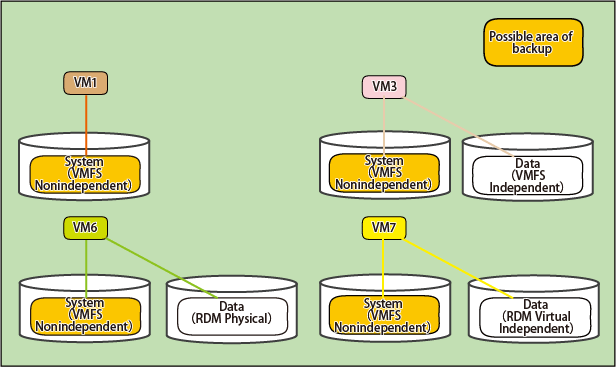The VMware script supports the following virtual machine data store configurations.
Item Number | Data Store Configured in VM | Supported by Script | Comments | |||
|---|---|---|---|---|---|---|
System Area | Data Area | Location of System Area and Data Area | System Area Only | System Area and Data Area | ||
1 | VMFS-5 Nonindependent | None | - | A | - | - |
2 | VMFS-5 Independent (Persistent) | Same Volume | N/A | - | - | |
3 | Separate volume | A | - | - | ||
4 | VMFS-5 Nonindependent | Same Volume | N/A | A | Recommended | |
5 | Separate volume | N/A | A | Recommended | ||
6 | RDM Compatibility Mode Physical | Separate volume | A | - (*1) | Recommended | |
7 | RDM Compatibility Mode Virtual Independent (Persistent) | Separate volume | A | - | - | |
8 | RDM Compatibility Mode Virtual Nonindependent | Separate volume | N/A | - | - | |
(-: Not supported, A: Available, N/A: Not available)
Recommended: Recommended configuration pattern for "E.1 Backup / Restoration in VMware Virtual Environment"
*1: If the Data Area is in RDM Compatibility Mode Physical, backup/restore the Data Area using the AdvancedCopy Manager's agent.
Examples of the configurations that can be backed up using the VMware script are shown below. The numbers for the VM names within the diagram correspond to the item number in "Table E.2 System Area and Data Area Configuration Supported by VMware Script".
Figure E.4 Examples of Configurations in Which Only System Area Can Be Backed Up

Figure E.5 Examples of Configurations in which System Area and Data Area are Backed up as Set

*1: In case of this configuration, it is not possible to back up only the System Area.